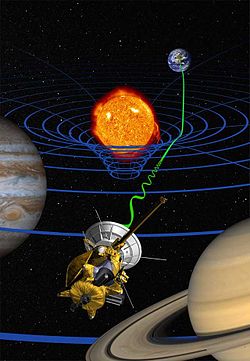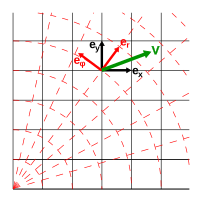All the mathematics discussed in this article were known before Einstein's general theory of relativity.
For an introduction based on the specific physical example of particles orbiting a large mass in circular orbits, see Newtonian motivations for general relativity for a nonrelativistic treatment and Theoretical motivation for general relativity for a fully relativistic treatment.
Contents |
Vectors and Tensors
Main articles: Euclidean vector and Tensor
Vectors
In mathematics, physics, and engineering, a Euclidean vector (sometimes called a geometric[1] or spatial vector[2], or – as here – simply a vector) is a geometric object that has both a magnitude (or length) and direction. A vector is what is needed to "carry" the point A to the point B; the Latin word vector means "one who carries".[3] The magnitude of the vector is the distance between the two points and the direction refers to the direction of displacement from A to B. Many algebraic operations on real numbers such as addition, subtraction, multiplication, and negation have close analogues for vectors, operations which obey the familiar algebraic laws of commutativity, associativity, and distributivity.Tensors
A Tensor extends the concept of a vector to additional dimensions. A scalar, that is, a simple set of numbers without magnitude, would be shown on a graph as a point, a zero-dimensional object. A vector, which has a magnitude and direction, would appear on a graph as a line, which is a one-dimensional object. A tensor extends this concepts to additional dimensions. A two dimensional tensor would be called a second order tensor. This can be viewed as a set of related vectors, moving in multiple directions on a plane.Applications
Vectors are fundamental in the physical sciences. They can be used to represent any quantity that has both a magnitude and direction, such as velocity, the magnitude of which is speed. For example, the velocity 5 meters per second upward could be represented by the vector (0,5) (in 2 dimensions with the positive y axis as 'up'). Another quantity represented by a vector is force, since it has a magnitude and direction. Vectors also describe many other physical quantities, such as displacement, acceleration, momentum, and angular momentum. Other physical vectors, such as the electric and magnetic field, are represented as a system of vectors at each point of a physical space; that is, a vector field.Common applications of tensors in physics include:
- Electromagnetic tensor (or Faraday's tensor) in electromagnetism
- Finite deformation tensors for describing deformations and strain tensor for strain in continuum mechanics
- Permittivity and electric susceptibility are tensors in anisotropic media
- Stress-energy tensor in general relativity, used to represent momentum fluxes
- Spherical tensor operators are the eigenfunctions of the quantum angular momentum operator in spherical coordinates
- Diffusion tensors, the basis of Diffusion Tensor Imaging, represent rates of diffusion in biologic environments
Dimensions
In relativity, four-dimensional vectors, or four-vectors are required. These four dimensions are length, height, width and time. In this context, a point would be an event, as it has both a location and a time. Similar to vectors, tensors require four dimensions. One example is the Riemann curvature tensor.Coordinate transformation
The importance of coordinate transformation is because relativity states that there is no one correct reference point in the universe. On earth, we use dimensions like north, east, and elevation, which are used throughout the entire planet. There is no such system for space. Without a clear reference grid, it becomes more accurate to describe the four dimensions as towards/away, left/right, up/down and past/future. As an example event, take the signing of the Declaration of Independence. To an modern observer on Mt Rainier looking East, Revere is ahead, to the right, below, and in the past. However, to an observer in Medieval England looking North, the event is behind, to the left, neither up or down, and in the future. The event itself has not changed, the location of the observer has.
Oblique axes
Main article: Metric tensor
An oblique coordinate system is one in which the axis are not necessarily orthogonal to each other; that is, at unusual angles.Nontensors
See also: Pseudotensor
A nontensor is a tensor-like quantity that behaves like a tensor in the raising and lowering of indices, but that does not transform like a tensor under a coordinate transformation.Curvilinear coordinates and curved spacetime

High-precision test of general relativity by the Cassini space probe (artist's impression): radio signals sent between the Earth and the probe (green wave) are delayed by the warping of space and time (blue lines) due to the Sun's mass. That is, the Sun's mass causes the regular grid coordinate system (in blue) to distort and have curvature. The radio wave then follows this curvature and moves toward the Sun.
A good example of this is the surface of the Earth. While maps frequently portray north, south, east and west as a simple square grid, that is not, in fact, the case. Instead, the longitude lines, running north and south, are curved, and meet at the north pole. This is because the Earth is not flat, but instead round.
In general relativity, gravity has curvature effects on the four dimensions of the universe. A common analogy is placing a heavy object on a stretched out rubber sheet which causes the rubber to bend downward. This creates a curved coordinate system around the object, much like an object in the universe creates a curved coordinate system. The mathematics here are much more complex than on Earth, as it results in four dimensions of curved coordinates instead of two as there are on Earth.
Parallel transport
Main article: Parallel transport

Example: Parallel displacement along a circle of a three-dimensional ball embedded in two dimensions. The circle of radius r is embedded in a two-dimensional space characterized by the coordinates z1 and z2. The circle itself is characterized by coordinates y1 and y2 in the two dimensional space. The circle itself is one-dimensional and can be characterized by its arc length x. The coordinate y is related to the coordinate x through the relation y1 = rcos(x / r) and y2 = rsin(x / r). This gives  and
and  . In this case the metric is a scalar and is given by g = cos2(x / r) + sin2(x / r) = 1. The interval is then ds2 = gdx2 = dx2. The interval is just equal to the arc length as expected.
. In this case the metric is a scalar and is given by g = cos2(x / r) + sin2(x / r) = 1. The interval is then ds2 = gdx2 = dx2. The interval is just equal to the arc length as expected.
 and
and  . In this case the metric is a scalar and is given by g = cos2(x / r) + sin2(x / r) = 1. The interval is then ds2 = gdx2 = dx2. The interval is just equal to the arc length as expected.
. In this case the metric is a scalar and is given by g = cos2(x / r) + sin2(x / r) = 1. The interval is then ds2 = gdx2 = dx2. The interval is just equal to the arc length as expected.The interval in a high dimensional space
Imagine our four-dimensional, curved spacetime is embedded in a larger N dimensional flat space. Any true physical vector lies entirely in the curved physical space. In other words, the vector is tangent to the curved physical spacetime. It has no component normal to the four-dimensional, curved spacetime.In the N dimensional flat space with coordinates
 the interval between neighboring points is
the interval between neighboring points isThe relation between neighboring contravariant vectors: Christoffel symbols
Main article: Christoffel symbol
The difference in  for two neighboring points in the surface differing by
for two neighboring points in the surface differing by  is
isNow shift the vector
 to the point
to the point  keeping it parallel to itself. In other words, we hold the components of the vector constant during the shift. The vector no longer lies in the surface because of curvature of the surface.
keeping it parallel to itself. In other words, we hold the components of the vector constant during the shift. The vector no longer lies in the surface because of curvature of the surface.The shifted vector can be split into two parts, one tangent to the surface and one normal to surface, as
 .
.
 be the components of
be the components of  in the x coordinate system. This transformation is given by:
in the x coordinate system. This transformation is given by: .
.
 is normal to every vector in the surface including the unit vectors that define the components of xμ. Therefore
is normal to every vector in the surface including the unit vectors that define the components of xμ. Therefore .
.
 .
.
Christoffel symbol of the second kind
The Christoffel symbol of the second kind is defined as .
.
This allows us to write
 .
.
 .
.
The constancy of the length of the parallel displaced vector
From Dirac:The constancy of the length of the vector follows from geometrical arguments. When we split up the vector into tangential and normal parts ... the normal part is infinitesimal and is orthogonal to the tangential part. It follows that, to the first order, the length of the whole vector equals that of its tangential part.
The covariant derivative
Main article: Covariant derivative
The partial derivative of a vector with respect to a spacetime coordinate is composed of two parts, the normal partial derivative minus the change in the vector due to parallel transport is covariantly constant, i.e.,
is covariantly constant, i.e.,  for any choice of i,j,k.
for any choice of i,j,k.The covariant derivative of a product is
Geodesics
Main article: Geodesic
Suppose we have a point zμ that moves along a track in physical spacetime. Suppose the track is parameterized with the quantity τ. The "velocity" vector that points in the direction of motion in spacetime isCurvature tensor
Main article: Riemann curvature tensor
Definition
The curvature K of a surface is simply the angle through which a vector is turned as we take it around an infinitesimal closed path. For a two dimensional Euclidean surface we have .
.
 .
.
 generalizes to
generalizes to is an arbitrary vector transported around a closed loop of area dxρdxσ along the
is an arbitrary vector transported around a closed loop of area dxρdxσ along the  and
and  directions.
directions.This expression can be reduced to the commutation relation
 .
.
Symmetries of the curvature tensor
The curvature tensor is antisymmetric in the last two indices .
.
 .
.
Bianchi identity
The following differential relation, known as the Bianchi identity is true.Ricci tensor and scalar curvature
The Ricci tensor is defined as the contraction .
.
 .
.
 .
.
See also
- Differentiable manifold
- Christoffel symbol
- Riemannian geometry
- Differential geometry and topology
- List of differential geometry topics
- General Relativity
- Gauge gravitation theory
Notes
- ^ Ivanov 2001
- ^ Heinbockel 2001
- ^ Latin: vectus, perfect participle of vehere, "to carry"/ veho = "I carry". For historical development of the word vector, see "vector n.". Oxford English Dictionary. Oxford University Press. 2nd ed. 1989. and Jeff Miller. "Earliest Known Uses of Some of the Words of Mathematics". http://jeff560.tripod.com/v.html. Retrieved 2007-05-25..
References
- P. A. M. Dirac (1996). General Theory of Relativity. Princeton University Press. ISBN 0-691-01146-X.
- Misner, Charles; Thorne, Kip S. & Wheeler, John Archibald (1973). Gravitation. San Francisco: W. H. Freeman. ISBN 0-7167-0344-0.
- Landau, L. D. and Lifshitz, E. M. (1975). Classical Theory of Fields (Fourth Revised English Edition). Oxford: Pergamon. ISBN 0-08-018176-7.
- R. P. Feynman, F. B. Moringo, and W. G. Wagner (1995). Feynman Lectures on Gravitation. Addison-Wesley. ISBN 0-201-62734-5.
- Einstein, A. (1961). Relativity: The Special and General Theory. New York: Crown. ISBN 0-517-02961-8.
























No comments:
Post a Comment